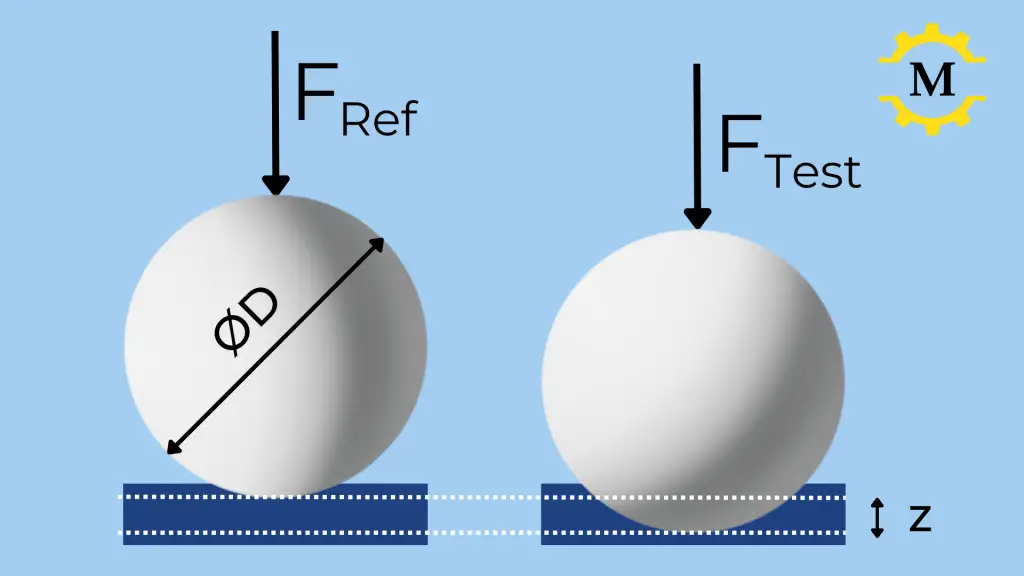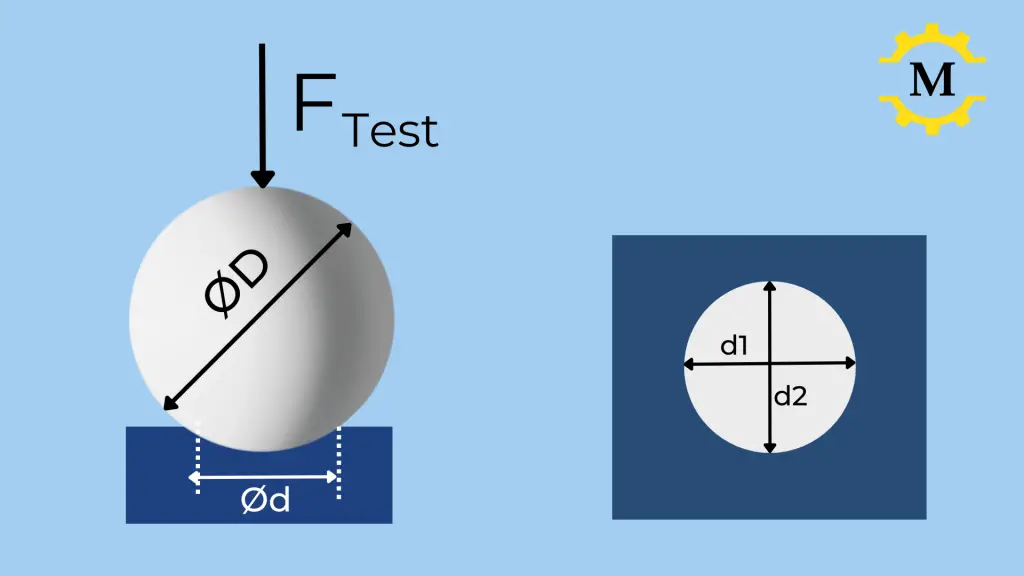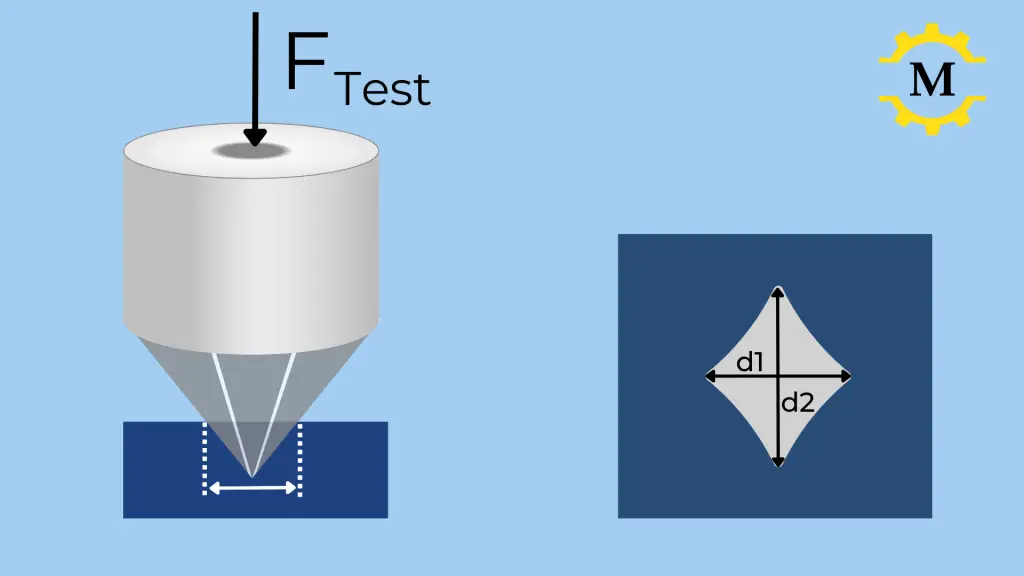Convert Hardness between HB, HV, HRC, and HRB
Table of Contents
What is Hardness?
Hardness measures the resistance to localized plastic deformation caused by force or abrasion. Materials with high hardness would generally be stronger and more wear-resistant but, on the other hand, more brittle and sensitive to fracture. Hardness is a broad topic that is well covered. In this post, we will cover it from the machining perspective.
Hardness units
Hardness is measured using several methods and units. The standard units used in the machining space are:

Rockwell [HRC/HRB/HRA] is one of the most common units used for listing the hardness of machined materials. The test is done by measuring the depth of penetration of a sphere under a large load compared to the penetration made by a reference preload. The Rockwell scale is divided into 9 sub-scales marked by letters A-K. Each scale uses a different reference load and different sphere sizes. In machining, the most common is the C scale (HRc]. Machined metal is usually between 10-65 HRC.

Brinell [HB] is one of the most common units used for listing the hardness of steel materials. The test is done with a 10 mm steel ball pressed with 3000 Kgf (6,614 Lbf). Common values for machined materials range from 100 HB for very soft materials up to 650 HB for heat-treated steels.
The advantage of Brinell [HB] over Rockwell [HRC/HRB], is that the whole range is covered on the scale, whereas in the Rockwell C scale, when the hardness is below 180 HB, you must switch to Rockwell B.

Vickers [HV] is a common unit for listing carbide grades’ hardness and other hard-cutting materials such as Ceramics, CBN, and PCD. The test is done by measuring the surface area of the indentation created by a diamond in the shape of a square-based pyramid. The HV number equals the force divided by the area (F/a). Carbide grades are usually in the range of 1,300-1,900 HV. Ceramics can reach a hardness of 2,000 HV, CBN up to 3,000 HV, and PCD up to 6,000 HV
Hardness in Machining
Hardness is one of the most critical parameters in any machining discussion since it affects the Material Removal Rate, the machine’s power consumption, and the tool life. It is the primary parameter to know for both the raw materials and the cutting materials.
Raw Materials
Although counter-intuitive, it is not ideal for machining very soft material. It is impossible to break chips below a certain hardness, and the raw material tends to stick on the cutting edge, causing BUE. From a certain hardness point, increasing the hardness further increases the wear and will either require you to reduce the cutting speed or settle for a lower tool life. Above a certain threshold, it will become impossible to machine the material with a conventional carbide insert, and advanced materials such as Ceramics and CBN will be mandatory.
Material Groups Hardness Range
| Material Group | HB | HRC |
|---|---|---|
| Steel (Annealed) | 70-270 | <28 |
| Steel (Quenched and tempered) | 270-350 | 29-38 |
| Steel (Hardened) | 350-750 | 39-68 |
| Stainless Steel (Austenitic) | 70-180 | <10 |
| Cast Iron | 180-300 | 10-32 |
| Aluminum | 60-100 | – |
| Heat resistance superalloys (Inconel) | 130-450 | <46 |
| Titanium | 70-370 | <40 |
Tungsten Carbide
Most cutting tools are made from Tungsten Carbide. Steel can reach after heat treatment hardness of up to 1,000 [HV]. Tungsten Carbide Grades range between 1300 and 2000 HV, and, therefore, are suitable to cut metals. The high hardness comes hand in hand with lower toughness and brittleness. Choosing a too-hard grade can cause catastrophic failure from insert breakage or lower tool-life due to the cutting edge’s chipping.
Carbide inserts recommended hardness per application.
| Grade Hardness | Hardness [Hv] | Application |
| Hard | 1700-1900 | Continuous turning in stable conditions |
| Balanced | 1500-1700 | Turning at less favorable conditions and Grooving |
| Tough | 1300-1500 | Milling, parting off or Turning with interrupted cut |
Conversion Chart
| BRINELL [HB] | ROCKWELL-C [HRC] | ROCKWELL-B [HRB] | VICKERS [HV] | Strength [N/mm^2] |
|---|---|---|---|---|
| 800 | 72 | |||
| 780 | 71 | |||
| 760 | 70 | |||
| 752 | 69 | |||
| 745 | 68 | |||
| 746 | 67 | |||
| 735 | 66 | |||
| 711 | 65 | |||
| 695 | 64 | |||
| 681 | 63 | |||
| 658 | 62 | |||
| 642 | 61 | |||
| 627 | 60 | |||
| 613 | 59 | |||
| 601 | 58 | 746 | ||
| 592 | 57 | 727 | ||
| 572 | 56 | 694 | ||
| 552 | 55 | 649 | ||
| 534 | 54 | 120 | 589 | |
| 513 | 53 | 119 | 567 | |
| 504 | 52 | 118 | 549 | |
| 486 | 51 | 118 | 531 | |
| 469 | 50 | 117 | 505 | |
| 468 | 49 | 117 | 497 | |
| 456 | 48 | 116 | 490 | 1569 |
| 445 | 47 | 115 | 474 | 1520 |
| 430 | 46 | 115 | 458 | 1471 |
| 419 | 45 | 114 | 448 | 1447 |
| 415 | 44 | 114 | 438 | 1422 |
| 402 | 43 | 114 | 424 | 1390 |
| 388 | 42 | 113 | 406 | 1363 |
| 375 | 41 | 112 | 393 | 1314 |
| 373 | 40 | 111 | 388 | 1265 |
| 360 | 39 | 111 | 376 | 1236 |
| 348 | 38 | 110 | 361 | 1187 |
| 341 | 37 | 109 | 351 | 1157 |
| 331 | 36 | 109 | 342 | 1118 |
| 322 | 35 | 108 | 332 | 1089 |
| 314 | 34 | 108 | 320 | 1049 |
| 308 | 33 | 107 | 311 | 1035 |
| 300 | 32 | 107 | 303 | 1020 |
| 290 | 31 | 106 | 292 | 990 |
| 277 | 30 | 105 | 285 | 971 |
| 271 | 29 | 104 | 277 | 941 |
| 264 | 28 | 103 | 271 | 892 |
| 262 | 27 | 103 | 262 | 880 |
| 255 | 26 | 102 | 258 | 870 |
| 250 | 25 | 101 | 255 | 853 |
| 245 | 24 | 100 | 252 | 838 |
| 240 | 23 | 100 | 247 | 824 |
| 233 | 22 | 99 | 241 | 794 |
| 229 | 21 | 98 | 235 | 775 |
| 223 | 20 | 97 | 227 | 755 |
| 216 | 19 | 96 | 222 | 716 |
| 212 | 18 | 95 | 218 | 706 |
| 208 | 17 | 95 | 210 | 696 |
| 203 | 16 | 94 | 201 | 680 |
| 199 | 15 | 93 | 199 | 667 |
| 191 | 14 | 92 | 197 | 657 |
| 190 | 13 | 92 | 186 | 648 |
| 186 | 12 | 91 | 184 | 637 |
| 183 | 11 | 90 | 183 | 617 |
| 180 | 10 | 89 | 180 | 608 |
| 175 | 9 | 88 | 178 | 685 |
| 170 | 7 | 87 | 175 | 559 |
| 167 | 6 | 86 | 172 | 555 |
| 166 | 5 | 86 | 168 | 549 |
| 163 | 4 | 85 | 162 | 539 |
| 160 | 3 | 84 | 160 | 535 |
| 156 | 2 | 83 | 158 | 530 |
| 154 | 1 | 82 | 152 | 515 |
| 149 | 81 | 149 | 500 | |
| 147 | 80 | 147 | 490 | |
| 143 | 79 | 146 | 482 | |
| 141 | 78 | 144 | 481 | |
| 139 | 77 | 142 | 480 | |
| 137 | 76 | 140 | 475 | |
| 135 | 75 | 137 | 467 | |
| 131 | 74 | 134 | 461 | |
| 127 | 72 | 129 | 451 | |
| 121 | 70 | 127 | 431 | |
| 116 | 68 | 124 | 422 | |
| 114 | 67 | 121 | 412 | |
| 111 | 66 | 118 | 402 | |
| 107 | 64 | 115 | 382 | |
| 105 | 62 | 112 | 378 | |
| 103 | 61 | 108 | 373 | |
| 95 | 56 | 104 | ||
| 90 | 52 | 95 | ||
| 81 | 41 | 85 | ||
| 76 | 37 | 80 |









